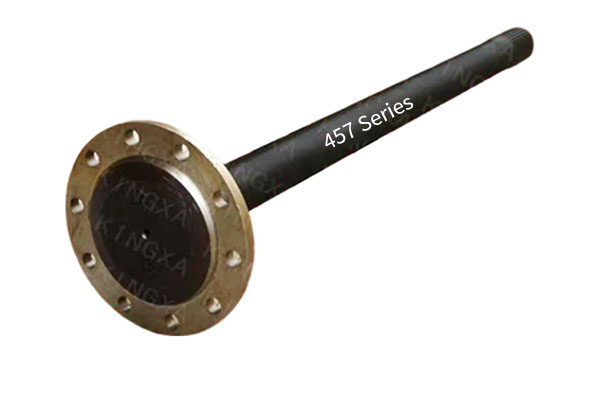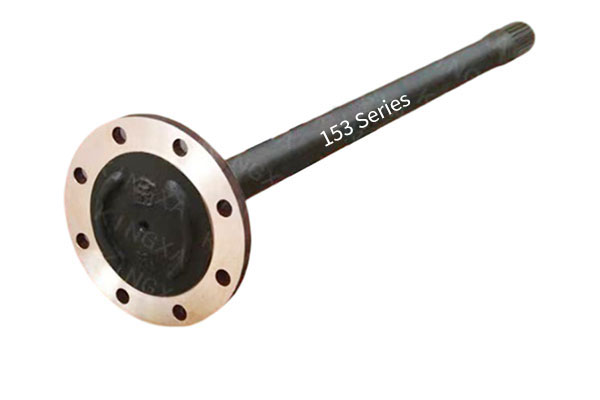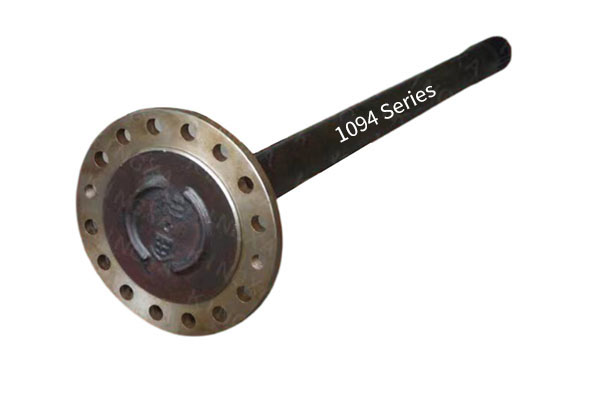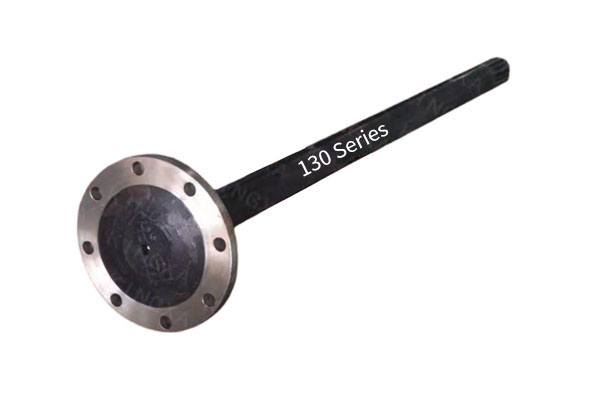How can automobile half shafts contribute to fuel conservation and emission reduction without sacrificing load-bearing performance?
Release Time : 2025-08-26
In a vehicle's powertrain, the automobile half-shaft (also known as the drive shaft), while not as visible as the engine or transmission, is the crucial "last link" in accurately transmitting power from the differential to the wheels. With increasingly stringent global requirements for energy conservation and emission reduction, automakers are constantly seeking breakthroughs in improving power efficiency and reducing energy consumption. As a core component in the powertrain, automobile half shafts are being developed through material innovation and structural optimization to achieve lightweighting while maintaining or even improving their load-bearing performance, becoming a crucial component in contributing to fuel conservation and emission reduction.
Lightweighting: The Physical Basis of Fuel Conservation and Emission Reduction
A vehicle's fuel consumption is positively correlated with its overall vehicle weight. Research shows that for every 10% reduction in curb weight, fuel economy improves by 6%-8%, while also reducing CO2 emissions. Therefore, lightweighting is one of the most direct and effective technical paths to achieving energy conservation and emission reduction. As components connecting the differential and wheels, rotating at high speeds for extended periods, reducing the weight of half-shafts not only reduces vehicle mass but also reduces rotational inertia, thereby minimizing energy loss during acceleration and improving power response efficiency.
Traditional half-shafts are often made of medium-carbon alloy steel. While offering high strength and load-bearing capacity, they are also heavy. Modern high-performance half-shafts are widely constructed using high-strength low-alloy steel (HSLA), micro-alloyed steel, or medium-carbon alloy steel, subjected to optimized heat treatment processes (such as medium-frequency induction hardening and tempering). These materials allow for thinner axle tube walls or smaller diameters while maintaining yield strength and fatigue life, significantly reducing weight. Some high-end models even employ hollow forging or composite coating to further achieve weight reduction without sacrificing structural integrity.
Structural Optimization: Striving for a Balance between Strength and Weight
Hyundai automobile half-shaft designs are highly refined. Using finite element analysis (FEA) and fatigue simulation techniques, engineers can accurately simulate stress distribution in the half-shaft under various operating conditions, thereby optimizing its geometry. For example, a variable-section design increases fillet radius in stress-concentrated areas (such as the spline root and shoulder transition zone) to reduce stress peaks. Optimizing the spline tooth profile and number of teeth reduces material usage while maintaining torque transmission capacity. A precision cold rolling strengthening process improves surface hardness and fatigue resistance, allowing for the use of lighter base materials.
In addition, the integrated design of the constant velocity joint (CV joint) significantly enhances the overall efficiency of the axle. High-precision ball bearings in the outer and inner CV joints ensure smooth power transmission and minimize frictional losses during wheel bounce and steering, improving driving comfort while also reducing energy waste caused by vibration and slip.
Load-bearing performance: the bottom line for safety and durability
Lightweighting doesn't necessarily come at the expense of safety and durability. Modern high-performance axles not only reduce weight but also improve their load-bearing capacity and fatigue life through material strengthening and process upgrades. The use of high-strength steel enables the axle to withstand higher torsional stresses and impact loads, meeting the demands of high-load vehicles such as SUVs and pickup trucks. Advanced heat treatment processes (such as quenching and tempering) ensure a perfect balance between core toughness and surface hardness, effectively resisting bending deformation and surface wear.
Additionally, improvements to the sealing structure extend the life of the universal joint. High-quality rubber dust covers and grease effectively isolate moisture and dust, preventing corrosion of the internal ball bearings and raceways, ensuring long-term stable operation of the halfshaft under harsh road conditions, reducing maintenance and replacement frequency, and indirectly reducing resource consumption and environmental impact.
Automobile half shafts are transforming from traditional "power movers" into intelligent transmission components that combine lightweighting, high efficiency, and high reliability. Through innovative materials, structural optimization, and precision manufacturing, they reduce weight and energy consumption without sacrificing load-bearing performance. Instead, they achieve comprehensive upgrades in strength, durability, and transmission efficiency. These seemingly minor technological advancements are converging into a solid force in the automotive industry's efforts to save energy and reduce emissions.
Lightweighting: The Physical Basis of Fuel Conservation and Emission Reduction
A vehicle's fuel consumption is positively correlated with its overall vehicle weight. Research shows that for every 10% reduction in curb weight, fuel economy improves by 6%-8%, while also reducing CO2 emissions. Therefore, lightweighting is one of the most direct and effective technical paths to achieving energy conservation and emission reduction. As components connecting the differential and wheels, rotating at high speeds for extended periods, reducing the weight of half-shafts not only reduces vehicle mass but also reduces rotational inertia, thereby minimizing energy loss during acceleration and improving power response efficiency.
Traditional half-shafts are often made of medium-carbon alloy steel. While offering high strength and load-bearing capacity, they are also heavy. Modern high-performance half-shafts are widely constructed using high-strength low-alloy steel (HSLA), micro-alloyed steel, or medium-carbon alloy steel, subjected to optimized heat treatment processes (such as medium-frequency induction hardening and tempering). These materials allow for thinner axle tube walls or smaller diameters while maintaining yield strength and fatigue life, significantly reducing weight. Some high-end models even employ hollow forging or composite coating to further achieve weight reduction without sacrificing structural integrity.
Structural Optimization: Striving for a Balance between Strength and Weight
Hyundai automobile half-shaft designs are highly refined. Using finite element analysis (FEA) and fatigue simulation techniques, engineers can accurately simulate stress distribution in the half-shaft under various operating conditions, thereby optimizing its geometry. For example, a variable-section design increases fillet radius in stress-concentrated areas (such as the spline root and shoulder transition zone) to reduce stress peaks. Optimizing the spline tooth profile and number of teeth reduces material usage while maintaining torque transmission capacity. A precision cold rolling strengthening process improves surface hardness and fatigue resistance, allowing for the use of lighter base materials.
In addition, the integrated design of the constant velocity joint (CV joint) significantly enhances the overall efficiency of the axle. High-precision ball bearings in the outer and inner CV joints ensure smooth power transmission and minimize frictional losses during wheel bounce and steering, improving driving comfort while also reducing energy waste caused by vibration and slip.
Load-bearing performance: the bottom line for safety and durability
Lightweighting doesn't necessarily come at the expense of safety and durability. Modern high-performance axles not only reduce weight but also improve their load-bearing capacity and fatigue life through material strengthening and process upgrades. The use of high-strength steel enables the axle to withstand higher torsional stresses and impact loads, meeting the demands of high-load vehicles such as SUVs and pickup trucks. Advanced heat treatment processes (such as quenching and tempering) ensure a perfect balance between core toughness and surface hardness, effectively resisting bending deformation and surface wear.
Additionally, improvements to the sealing structure extend the life of the universal joint. High-quality rubber dust covers and grease effectively isolate moisture and dust, preventing corrosion of the internal ball bearings and raceways, ensuring long-term stable operation of the halfshaft under harsh road conditions, reducing maintenance and replacement frequency, and indirectly reducing resource consumption and environmental impact.
Automobile half shafts are transforming from traditional "power movers" into intelligent transmission components that combine lightweighting, high efficiency, and high reliability. Through innovative materials, structural optimization, and precision manufacturing, they reduce weight and energy consumption without sacrificing load-bearing performance. Instead, they achieve comprehensive upgrades in strength, durability, and transmission efficiency. These seemingly minor technological advancements are converging into a solid force in the automotive industry's efforts to save energy and reduce emissions.







